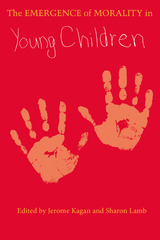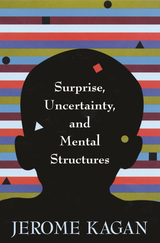
How malleable is human nature? Can an individual really change in meaningful ways? Or, are there immutable limits on the possibilities of human growth set in place by the genes and by the early experiences of childhood? These are questions which touch our deepest political and personal concerns; and they have long been a matter of fierce debate in the behavioral sciences.
Constancy and Change in Human Development takes a thorough inventory of the growing body of research which now bears upon these questions. Editors Brim and Kagan have assembled an outstanding group of specialists in human growth and commissioned them to assess questions of change and continuity in physical, mental, and emotional development throughout the life span. Beginning with three general chapters which place the ideas of continuity and discontinuity in historical and philosophical perspective, the book moves across a broad spectrum of developmental issues, ranging from the basic adaptability of the human central nervous system to the effects of social institutions which seek to promote individual change. There are chapters on physical growth, health, cognitive development, personality, social attitudes and beliefs, occupational careers, psychosis, and criminal behavior. Throughout these chapters, the recurring question is whether development can be seen as a continuous process in which early stages reliably predict subsequent events, or whether instead there are sharp discontinuities which render individual development essentially unpredictable. The variety and richness of the answers to this question provide a summary of human development which is unparalleled in any other single volume.

"This is a welcome and immensely provocative book. For those of us who favor ethical theorizing done in close proximity to psychology and anthropology, it provides new and illuminating theory and research relevant to perennial debates about the origins of moral sense, its psychological organization, and the objectivity and unity of the moral."—Owen Flanagan, Ethics
The contributors are Augusto Blasi, Lawrence Blum, Judy Dunn, M. Ann Easterbrooks, Carolyn Pope Edwards, Robert Emde, Carol Gilligan, Charles C. Helwig, William F. Johnson, Jerome Kagan, Melanie Killen, Sharon Lamb, Manamohan Mahapatra, Joan G. Miller, Edward Mueller, Richard A. Shweder, Catherine Snow, Elliot Turiel, and Grant Wiggins.

Here is a major new work on human infancy written by one of the country's leading developmental psychologists and two distinguished colleagues. At its core is the long-awaited report of the authors' six-year study of infant daycare. Important in its own right, this experiment becomes the occasion for a wide-ranging discussion of cognitive and emotional processes in infancy, of the effects of early experience on later growth, and of the deep-seated cultural and historical assumptions that underlie our views of human development.
For those concerned with social policy, the book provides the best empirical assessment now available of the effects of group care on the psychological well-being of infants. It also supplies a blueprint for quality daycare that may well stand as a model for future nurseries.
For those interested in the course of cognitive and emotional development, the book provides rich information about the major growth functions that characterize human infancy. It also outlines an explanation of these growth functions that links changes in emotional behavior to the maturation of underlying cognitive processes in a new and provocative way.
And for everyone interested in human nature, the book of offers a controversial thesis about the discontinuity of psychological growth that challenges some of our most fundamental assumptions about the nature of individual development.

Here is a major new work on human infancy written by one of the country’s leading developmental psychologists and two distinguished colleagues. At its core is the long-awaited report of the authors’ six-year study of infant day care. Important in its own right, this experiment becomes the occasion for a wide-ranging discussion of cognitive and emotional processes in infancy, of the effects of early experience on later growth, and of the deep-seated cultural and historical assumptions that underlie our views of human development.
For those concerned with social policy, the book provides the best empirical assessment now available of the effects of group care on the psychological well-being of infants. It also supplies a blueprint for quality daycare that may well stand as a model for future nurseries. For those interested in the course of cognitive and emotional development, the book provides rich information about the major growth functions that characterize human infancy. It also outlines an explanation of these growth functions that links changes in emotional behavior to the maturation of underlying cognitive processes in a new and provocative way. And for everyone interested in human nature, the book of offers a controversial thesis about the discontinuity of psychological growth that challenges some of our most fundamental assumptions about the nature of individual development.
For this paperback edition, the statistical summary has been removed from the appendix to shorten the work and make it even more appealing to the general reader.

We have seen these children—the shy and the sociable, the cautious and the daring—and wondered what makes one avoid new experience and another avidly pursue it. At the crux of the issue surrounding the contribution of nature to development is the study that Jerome Kagan and his colleagues have been conducting for more than two decades. In The Long Shadow of Temperament, Kagan and Nancy Snidman summarize the results of this unique inquiry into human temperaments, one of the best-known longitudinal studies in developmental psychology. These results reveal how deeply certain fundamental temperamental biases can be preserved over development.
Identifying two extreme temperamental types—inhibited and uninhibited in childhood, and high-reactive and low-reactive in very young babies—Kagan and his colleagues returned to these children as adolescents. Surprisingly, one of the temperaments revealed in infancy predicted a cautious, fearful personality in early childhood and a dour mood in adolescence. The other bias predicted a bold childhood personality and an exuberant, sanguine mood in adolescence. These personalities were matched by different biological properties. In a masterly summary of their wide-ranging exploration, Kagan and Snidman conclude that these two temperaments are the result of inherited biologies probably rooted in the differential excitability of particular brain structures. Though the authors appreciate that temperamental tendencies can be modified by experience, this compelling work—an empirical and conceptual tour-de-force—shows how long the shadow of temperament is cast over psychological development.

The second year is that daunting time when the previously docile and adorable infant inevitably develops a mind of her own. In this book, Jerome Kagan takes a provocative look at the mental developments underlying the startling transitions in the child’s second year.
It is Kagan’s premise that the roots of self-awareness emerge in the second half of the second year of life. He also suggests that the underlying cause may be more biological than social. His book develops these ideas through a series of brilliant observations on the behavior of two-year-olds.
Kagan charts, for example, the emerging sense of standards (the possibility of right and wrong) that reveals itself positively when the child suddenly begins to smile after a successful action, and negatively when the child starts to become concerned about flaws in objects and mistakes in her own behavior. When this concern with standards spreads to the child’s irresistible impulse to imitate adults, Kagan observes a remarkable phenomenon: the twenty-month-old child suddenly begins to show signs of distress before she even tries to imitate an action that is beyond her ability. Kagan argues that this distress could arise only from the child’s growing sense of what she can and can’t do—her awareness of herself.

When we are startled by the new, confronted with discrepancies, our knowing gives way to uncertainty—and changes. In the distinctive manner that has made him one of the most influential forces in developmental psychology, Jerome Kagan challenges scientific commonplaces about mental processes, pointing in particular to the significant but undervalued role of surprise and uncertainty in shaping behavior, emotion, and thought.
Drawing on research in both animal and human subjects, Kagan presents a strong case for making qualitative distinctions among four different types of mental representation—perceptual schemata, visceral schemata, sensorimotor structures, and semantic networks—and describes how each is susceptible to the experience of discrepancy and the feeling of surprise or uncertainty. The implications of these findings are far-reaching, challenging current ideas about the cognitive understandings of infants and revealing the bankruptcy of contemporary questionnaire-based personality theory. More broadly, Kagan’s daring, thoroughly informed, and keenly reasoned book demonstrates the risks of making generalizations about human behavior, in which culture, context, and past experience play such paramount and unpredictable roles.


Do the first two years of life really determine a child’s future development? Are human beings, like other primates, only motivated by pleasure? And do people actually have stable traits, like intelligence, fear, anxiety, and temperament? This book, the product of a lifetime of research by one of the founders of developmental psychology, takes on the powerful assumptions behind these questions—and proves them mistaken. Ranging with impressive ease from cultural history to philosophy to psychological research literature, Jerome Kagan weaves an argument that will rock the social sciences and the foundations of public policy.
Scientists, as well as lay people, tend to think of abstract processes—like intelligence or fear—as measurable entities, of which someone might have more or less. This approach, in Kagan’s analysis, shows a blindness to the power of context and to the great variability within any individual subject to different emotions and circumstances. “Infant determinism” is another widespread and dearly held conviction that Kagan contests. This theory—with its claim that early relationships determine lifelong patterns—underestimates human resiliency and adaptiveness, both emotional and cognitive (and, of course, fails to account for the happy products of miserable childhoods and vice versa). The last of Kagan’s targets is the vastly overrated pleasure principle, which, he argues, can hardly make sense of unselfish behavior impelled by the desire for virtue and self-respect—the wish to do the right thing.
Written in a lively style that uses fables and fairy tales, history and science to make philosophical points, this book challenges some of our most cherished notions about human nature.

In his most probing and expansive work to date, Jerome Kagan—one of this country’s leading psychologists—demonstrates that innovative research methods in the behavioral sciences and neurobiology, together with a renewed philosophical commitment to rigorous empiricism, are transforming our understanding of human behavior. Contemporary psychology, according to Kagan, has been preoccupied with three central themes: How malleable is temperament? How predictable are the milestones of cognitive development? How accurate is consciousness as a window onto the self, its motives, beliefs, and emotions?
In a review of past approaches to these questions, Kagan argues persuasively that behavioral scientists have reached less-than-satisfactory answers because they have failed to appreciate the biases inherent in their frame of reference and the limitations of their investigative procedures. He calls into question a number of techniques that have been mainstays of psychological investigation: the Ainsworth Strange Situation for assessing the emotional attachment of an infant to its mother, and interviews and questionnaires as indexes of personality, to name only two. Kagan’s own research has used novel laboratory situations to discover a group of children who exhibit a pattern of behavior he calls “temperamentally inhibited”—they are restless and irritable from birth, and by twenty-four months cling to the mother and show biological signs of high anxiety in unfamiliar situations.
These findings, coupled with current understanding of the structure and chemistry of the nervous system, lead him to speculate that these children are born with a biological predisposition that favors the development of a shy, fearful personality. Through longitudinal studies of this kind, as well as through his cross-cultural investigations of cognitive development, Kagan has infused new meaning into the nature–nurture debate.
READERS
Browse our collection.
PUBLISHERS
See BiblioVault's publisher services.
STUDENT SERVICES
Files for college accessibility offices.
UChicago Accessibility Resources
home | accessibility | search | about | contact us
BiblioVault ® 2001 - 2024
The University of Chicago Press









